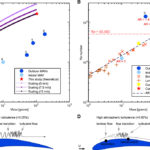Paper, A bioinspired Separated Flow wing provides turbulence resilience and aerodynamic efficiency for miniature drones
“Small-scale drones have enough sensing and computing power to find use across a growing number of applications. However, flying in the low–Reynolds number regime remains challenging. High sensitivity to atmospheric turbulence compromises vehicle stability and control, and low aerodynamic efficiency limits flight duration. Conventional wing designs have thus far failed to address these two deficiencies simultaneously. Here, we draw inspiration from nature’s small flyers to design a wing with lift generation robust to gusts and freestream turbulence without sacrificing aerodynamic efficiency. This performance is achieved by forcing flow separation at the airfoil leading edge. Water and wind tunnel measurements are used to demonstrate the working principle and aerodynamic performance of the wing, showing a substantial reduction in the sensitivity of lift force production to freestream turbulence, as compared with the performance of an Eppler E423 low–Reynolds number wing. The minimum cruise power of a custom-built 104-gram fixed-wing drone equipped with the Separated Flow wing was measured in the wind tunnel indicating an upper limit for the flight time of 170 minutes, which is about four times higher than comparable existing fixed-wing drones. In addition, we present scaling guidelines and outline future design and manufacturing challenges.”
Learn about our two Decals!
 Click here to find out more about our Fall Bioinspired Design Decal and our Spring Bioinspired Design in Action Decal – ALL MAJORS are welcome.
Click here to find out more about our Fall Bioinspired Design Decal and our Spring Bioinspired Design in Action Decal – ALL MAJORS are welcome.Berkeley BioDesign Community
 Click here to learn about the BioD: Bio-Inspired Design @ Berkeley student organization or here to signup for more info.
Click here to learn about the BioD: Bio-Inspired Design @ Berkeley student organization or here to signup for more info.Search
Student Login




I imagine that the neurological circuits underlying these processes are governed by both 2d spacing maps with their brains as…
to reduce the impact of car accidents, it may be possible to study the force diverting physics of cockroaches to…
you see this type of head-bobbing stability in many avian creatures related to pigeons like chickens. the head ability to…
not like they taught horses how to run! this is an example of convergent evolution where both sea creatures and…
The brain functions in a similar way with neuronal connections. our brains are able to utilize the multiplicity of connections…